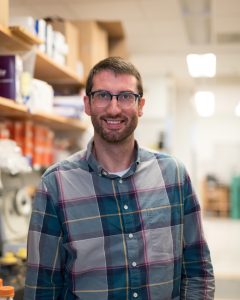 Congratulations Nick Martinez (Campbell lab) on his first authored paper in Journal of Molecular Biology! “Biophysical and structural characterization of novel RAS-binding domains (RBDs) of PI3Kα and PI3Kγ”
Congratulations Nick Martinez (Campbell lab) on his first authored paper in Journal of Molecular Biology! “Biophysical and structural characterization of novel RAS-binding domains (RBDs) of PI3Kα and PI3Kγ”
Summary
The KRAS/PI3Ka interaction is a crucial interaction in cancer, but the only available structural information is of the RAS/PI3Kg complex. Isolated binding domains of RAS effectors are commonly used for biophysical and structural studies of RAS/effector interactions due to difficulties in generating functional full-length effector proteins. PI3K is difficult to generate, produced in low yield and with variable activity, so we generated and characterized functional RAS binding domains (RBDs) for PI3Ka and PI3Kg that associate with GTP-RAS with similar affinity to full-length PI3K isoforms. These novel PI3K RBDs will facilitate characterization of RAS/PI3K interactions and provide new insights into how PI3K isoforms differentially recognize RAS. This knowledge could help expedite drug discovery efforts that aim to inhibit the KRAS/PI3Ka interaction.
Abstract
Phosphatidylinositol-3-kinases (PI3Ks) are lipid kinases that phosphorylate phosphatidylinositol 4,5-bisphosphate to generate a key lipid second messenger, phosphatidylinositol 3,4,5-bisphosphate. PI3Ka and PI3Kg require activation by RAS proteins to stimulate signaling pathways that control cellular growth, differentiation, motility and survival. Intriguingly, RAS binding to PI3K isoforms likely differ, as RAS mutations have been identified that discriminate between PI3Ka and PI3Kg, consistent with low sequence homology (23%) between their RAS binding domains (RBDs). As disruption of the RAS/PI3Ka interaction reduces tumor growth in mice with RAS- and epidermal growth factor receptor driven skin and lung cancers, compounds that interfere with this key interaction may prove useful as anti-cancer agents. However, a structure of PI3Ka bound to RAS is lacking, limiting drug discovery efforts. Expression of full-length PI3K isoforms in insect cells has resulted in low yield and variable activity, limiting biophysical and structural studies of RAS/PI3K interactions. This led us to generate the first RBDs from PI3Ka and PI3Kg that can be expressed at high yield in bacteria and bind to RAS with similar affinity to full-length PI3K. We also solved a 2.31 Å X-ray crystal structure of the PI3Ka-RBD, which aligns well to full-length PI3Ka. Structural differences between the PI3Ka and PI3Kg RBDs are consistent with differences in thermal stability and may underly differential RAS recognition and RAS-mediated PI3K activation. These high expression, functional PI3K RBDs will aid in interrogating RAS interactions and could aid in identifying inhibitors of this key interaction.
About Nicholas G. Martinez
After initially pursuing a career as a K-3rd grade elementary school teacher with additional training and coursework in special education and ESL, Nick Martinez switched careers paths to pursue his dream of being a cancer researcher. Using his mother’s passing from colon cancer at an early age as motivation, he gained a strong academic and research background in biochemistry and structural biology at the University of Kansas and through an NSF REU summer research fellowship in 2016 at Brandeis University. Nick Martinez chose to continue his graduate education at the University of North Carolina at Chapel Hill, where he is currently pursuing a Ph.D. in Biochemistry & Molecular Biology in Dr. Sharon Campbell’s lab.
He is currently a 4th year BCBP graduate student with an expected graduation date is December 2021. Nick will be joining Dr. Georgios Skiniotis’ lab at Stanford University as a postdoctoral fellow to gain cryo-EM experience prior to heading into industry.
“Biophysical and structural characterization of novel RAS-binding domains (RBDs) of PI3Kα and PI3Kγ”
All authors: Nicholas G. Martinez, David F. Thieker, Leiah M. Carey, Juhi A. Rasquinha, Samantha K. Kistler, Brian A. Kuhlman, Sharon L. Campbell. Department of Biochemistry & Biophysics, UNC at Chapel Hill and Lineberger Comprehensive Cancer Center, UNC at Chapel Hill.
